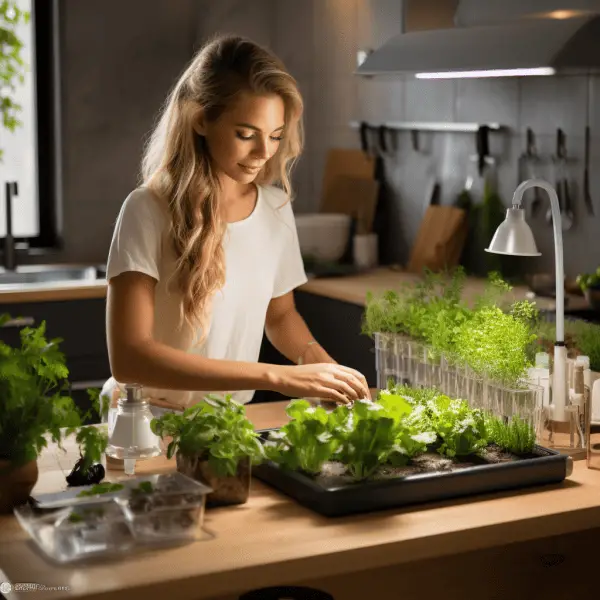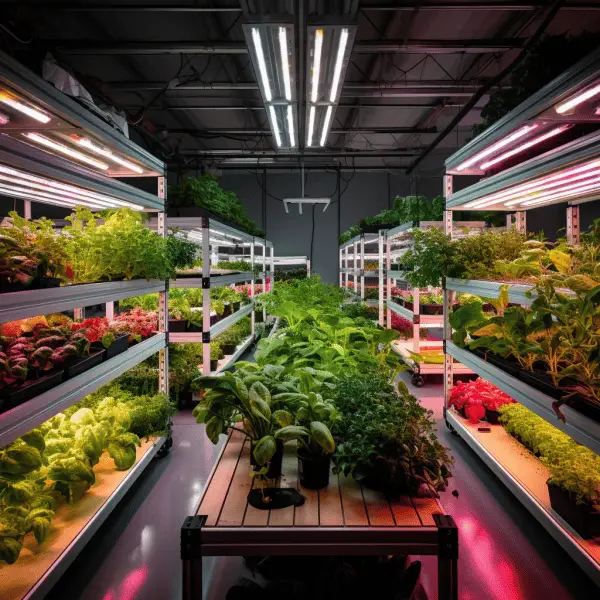Hey green thumbs, want to take your gardening to the next level?
Have you heard about the magical world of hydroponics?
That’s growing plants without soil by feeding their roots directly with nutrient-rich water.
Wild, right? Many new hydro growers use pre-made commercial kits to dip their toes in.
But are commercial hydroponic kits worth the investment? Let me spill the tea!
As a former black-thumb who could kill cacti, I thought fancy hydroponics was not for me.
Then my hipster neighbor Trevor invited me to his rooftop hydroponic oasis.
I was shocked to see massive tomato vines and bountiful lettuce rows thriving in his homemade PVC pipe system.
Right then I caught the hydro bug!
But being craft-challenged, I knew DIY was not in my cards.
After tons of Googling, I took a leap with a commercial hydroponic kit.
While not cheap, that little kit yielded so much delicious basil and lettuce that I was eating Cobb salads every day! Now I’m a hydroponics evangelist.
Keep reading to hear my experiences and decide if a commercial kit is worth it for you too!
KEY TAKEAWAY
Are commercial hydroponic kits worth the investment?
Investing in commercial hydroponic kits can yield substantial benefits, such as higher yields, faster growth, and water-efficient farming. (1)
However, assessing factors like initial costs, maintenance, and market demand is crucial to determine if the investment aligns with your business goals.
Factors Affecting Hydroponic System Investment
Taking your gardening to the next level with a hydroponic (2) setup can bring huge rewards.
But what factors determine whether it’s a sound investment? As your hydroponics financial advisor, let me break it down!
First, consider your goals – is this a small backyard hobby or large commercial farm venture? The system scale you need and associated costs differ greatly.
Are you growing quick turnover leafy greens or long-term fruiting crops? The payback timeline varies.
Define your vision to size your investment wisely.
Next, research system setup costs like structure, equipment, growing media, and hardware.
Factor in ongoing supply expenses too – electricity, water, nutrients, maintenance.
Understand total operating costs before investing.
Don’t forget your time commitment too for monitoring and care.
Now for the payoff – analyze potential crop yields and growth rates with the system chosen.
Faster harvests mean quicker returns.
Check current market prices for your planned crops.
Crunching the numbers will estimate your potential revenues so you can project profitability.
Evaluating all these factors helps determine if a specific hydroponic investment makes financial sense for your situation and goals.
With prudent planning, your soilless endeavor can yield bountiful returns! Let’s grow!
Cost Breakdown: Setup, Materials, and Operating Expenses

Wondering what costs are involved in a hydroponic setup? As a number-crunching gardening nerd, let me break down the typical expenses.
Initial purchases include the structure like tents or greenhouse, system equipment like pumps and piping, growing media, supplemental lighting, and hardware.
These * startup costs* vary based on system scale and components selected.
Ongoing supply expenses are your operational costs like electricity, water, nutrients, pH adjuster, replacement parts, and maintenance items.
These recurring costs depend on your system’s size and technologies used.
Don’t forget time commitments too – daily monitoring and management is required, especially with larger systems.
Hiring paid growers is an operational expense to consider if you can’t handle alone.
Add up all one-time setup items plus estimated recurring operating costs to gauge total investment.
Tracking actual costs once running helps refine future budgeting.
Just be diligent – the numbers don’t lie!
Financial Returns: Yield, Growth Rate, and Revenue Prospects
What’s up future farming moguls? Once your hydroponic operation is up and running, how do you estimate potential financial returns? Here are key factors to consider.
First, research the typical yield per area for your chosen crops and system.
Faster-growing leafy greens offer 3-5 harvests annually versus 1-2 for fruiting plants.
The growth rate impacts your overall production capacity.
Next, project your total annual yields by accounting for multiple crop cycles, actual growing area, and realistic productivity estimates.
This gives your production volume.
Then check current market prices for those crops to determine potential crop value.
Compare wholesale vs. retail and farmgate vs. grocery store pricing.
Factor in production and distribution costs to calculate your profit margin.
Anticipate best and worst case annual revenue scenarios given fluctuations in yields, prices, and costs.
Crunching these numbers helps estimate if a commercial hydroponic operation can generate sufficient income to warrant the investment.
Analyze the projections to make a savvy business decision!
Success Stories: Real-Life Examples of Profitable Hydroponics

Still wondering if hydroponics can really be a money-maker? Well let me share some true tales of hydroponic success.
Get inspired by these real-life examples of profitable hydro farms!
First up is my neighbor Jenny who is earning big bucks growing lettuce hydroponically in her backyard greenhouse.
With multiple crop cycles per year and premium prices for uber-local salad greens, Jenny’s hydro garden provides a six-figure income!
Then there’s innovative Omar.
He transformed a vacant urban warehouse into a five-story vertical hydroponic farm.
Growing specialty herbs and microgreens for upscale restaurants and grocers, his leading-edge operation nets over a million dollars annually!
And we can’t forget savvy Susanna.
She contracted with local schools to provide student-grown hydroponic produce from classroom farms.
Teaching future generations soilless agriculture while earning over $100,000 through school districts’ yearly contracts.
Brilliant!
These are just a few real-world examples of profitable hydroponic farms I’ve encountered.
Driven growers plus the right business model, crops, and systems can absolutely lead to soilless success! Let’s grow!
Profitable Plants: Maximizing Income with Hydroponic Crops
Green thumbs, wondering what hydroponic crops offer prime money-making potential?
As a friend to many prosperous hydro farmers, let me share the inside scoop on profit-boosting hydroponic plants.
Quick-harvest leafy greens like lettuces, spinach, kale, arugula offer multiple lucrative crop cycles per year.
Herbs are another fast grower than command premium pricing.
Heirloom tomato varieties, colored bell peppers, and mini cucumbers fetch higher market prices than conventional produce.
Edible flowers also sell for top dollar.
Exotic microgreens like pea shoots, radish greens, sunflower sprouts satisfy demand from discerning chefs.
Vertical or stacked systems maximize microgreen yields per square foot.
Don’t overlook value-added products either.
Pesto from hydroponic basil, salad dressing from produce, jarred relishes from veggies extend sales opportunities.
Focusing on the right plants for your market optimizes income potential.
Do research to match specialized varieties and value-added products to buyer needs and price points.
Economic Comparison: Hydroponics vs. Traditional Farming
Pondering if hydroponic growing can really be more economical than traditional soil farming? As an ag-economics nerd, let me crunch some numbers.
For starters, hydroponics provides higher crop yields per square foot.
No space wasted on walkways, and vertical systems stack layers.
More plants = more produce = more sales.
Indoor climate control enables year-round production, versus seasonal limits outdoors.
Multiple crop cycles further boost annual yields.
Hydroponic growers access premium prices – local, pesticide-free, specialty varieties fetch higher market value.
Faster growth cycles mean faster returns.
No lengthy field rotations between crops.
Automation and optimized conditions reduce labor expenses and uncertainty.
Less time and effort expended overall.
When factors like space efficiency, consistent production, labor savings, and premium pricing are considered, hydroponics can certainly prove more economical.
The numbers tell an exciting tale!
Choosing the Right Hydroponic System for Commercial Use
Starting a large-scale soilless farm? The system you choose is key! As your hydroponic design consultant, let me offer advice for selecting the ideal setup.
First, consider your space and crops.
Vertical systems, stacked beds, or towers maximize yield in a compact footprint.
Vine crops need ample trellising.
Leafy greens grow great in rectangular troughs or raft setups.
Match system and layout to your plants.
Next, weigh factors like irrigation type, reservoir size, materials, and hardware components based on your scale.
Larger farms need durable commercial-grade equipment for heavy use.
Automated systems may be preferred for hands-off operation.
Carefully calculate electrical, water, and environmental control requirements.
Oversizing capacity provides a buffer during peak loads.
Backup power options are wise for large farms too.
Lastly, don’t forget upfront and ongoing costs for system purchase, maintenance, and operation.
Choose equipment that balances durability with energy and labor efficiency.
Selecting the optimal commercial hydroponic system takes research and planning.
But the investment will pay off with efficient, productive food production for years to come!
Assessing Hydroponic Farming as a Lucrative Business Venture
Calling all budding agripreneurs! Is a commercial hydroponic farm in your future? As a business-savvy gardener, let me share advice for assessing the money-making potential.
Start by defining your market – do you plan to supply grocery stores, restaurants, farmers markets or use a CSA model?
Research buyer needs and pricing for your target customer segments.
Next, analyze operating expenses like systems, utilities, labor, supplies, and distribution.
Compare against projected revenues based on crop selection, yields, and prices.
Consider efficiency factors too – hydroponics can produce more per square foot with faster turnaround between multiple crop cycles annually.
This optimizes your production capacity.
Account for location benefits if siting in an urban “food desert” or growing locally in winter.
Hydroponics can access premium prices year-round.
Crunching the numbers will estimate net profit potential.
Connect with existing farms to learn real-world economics.
With proper planning and prudent investment, a hydroponic farm can absolutely be a lucrative business! Let the growing begin.
Conclusion
And there’s my take on commercial hydroponic kits – are they worth the investment?
Based on my experiences, I say yes!
While not the cheapest option, a good pre-made kit provides everything you need to dive into hydroponics and start growing.
No advanced DIY skills required.
I hope my journey has shown how a quality commercial system can turn anyone into a hydroponic farmer.
The kits recommended above make it so easy to set up your first soilless garden.
Just add some seeds and let your green thumb bloom!
If you’re still hesitant, start small with a mini herb garden kit.
Once you taste that hydroponic basil, you’ll be hooked like me! Life is too short for flimsy lettuce.
With these kits, you can grow robust greens and veggies that will make your tastebuds sing.
Join the soil-free revolution! Ditch the dirt and get growing with an all-in-one commercial hydroponic system.
Your plants will thank you.
And your salads will never be the same.
Happy gardening!
References
- https://www.globalgarden.co/knowledge/overview-of-commercial-hydroponic-systems/#:~:text=Although%20the%20start%2Dup%20costs,the%20same%20amount%20of%20space.
- https://www.nal.usda.gov/farms-and-agricultural-production-systems/hydroponics#:~:text=Hydroponics%20is%20the%20technique%20of,%2C%20hobbyists%2C%20and%20commercial%20enterprises.
Related Articles
- https://tophydroponicgarden.com/best-commercial-hydroponic-kits/
- https://tophydroponicgarden.com/commercial-hydroponic-kits/
- https://tophydroponicgarden.com/hydroponic-kits/
Was this helpful?

Crystal Erickson is an agriculture enthusiast and writer with a passion for sustainable farming practices and community development. Growing up on a family farm in rural Iowa, Crystal developed a love for the land and a deep appreciation for the hard work and dedication required to make a farm successful.
After completing a degree in Agriculture and Environmental Science from Iowa State University, Crystal began her career as an agricultural journalist, covering stories and issues related to modern farming practices, crop management, and livestock production. She quickly established herself as a respected voice in the industry, known for her insightful reporting and thoughtful analysis.
Over the years, Crystal has written for a variety of publications, including Farm Journal, Successful Farming, and Modern Farmer, as well as contributing to several academic journals focused on sustainable agriculture and community development. Her work has been recognized with numerous awards, including the Iowa Farm Bureau’s Young Farmer Achievement Award and the National Association of Farm Broadcasting’s Farm Broadcaster of the Year.


